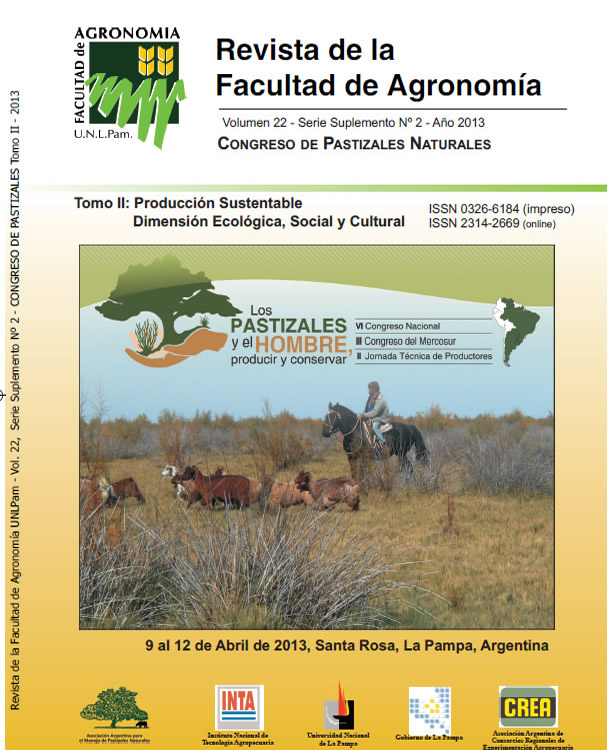Roller –chopping and water infiltration in soils of the western chaco region
Keywords:
Water cycle, Mechanical treatments, HydrologyAbstract
Roller chopping is widely used in the Chaco region as a means to increase standing forage and accessibility. By modifying vegetation structure, roller-chopping may affect water infiltration in soils, a key attribute of the ecosystem. During 2006-2007 soil water infiltration was assessed using the double ring infiltrometer in four ranches of the western Chaco(EST), in controls and roller-chopped paddocks (TRAT). Data were adjusted to the Kostiakov equation, and the m and k parameters were analyzed using ANOVA with EST and TRAT as independent variables. The coefficient m was not statistically affected, but k was significantly modified by EST (P > F = 0,0001) y EST*TRAT (P > F = 0,0022). Controls showed a larger mean k than the treated paddocks, but in a ranch recently roller-chopped. Results are attributed to the severity and intensity of the roller-chopping and to the post-grazing management, rather than to the mechanical operation itself.
Downloads
References
Arshad M. & S. Martin. 2002. Identifying critical limits for soil quality indicators in agro-ecosystems. Agric. Ecosys. Environ. 88: 153-160.
Dunne T., D. Western & W. Dietrich 2011. Effects of cattle trampling on vegetation, infiltration and erosion in a tropical rangeland. J. Arid Environ. 75: 58-69.
Fulbright T. 2004. Disturbance effects on species richness of herbaceous plants in a semiarid habitat. J. Arid Environ. 58: 119-133.
García Hernández M., M. García Hernández, I. Castellanos Vargas, Z. Cano Santana & C. Peláez Rocha 2008. Variación de la velocidad de infiltración media en seis ecosistemas inalterados. Terra Latinoamericana 26: 21-27.
Hester J., T. Thurow & C. Taylor. 1997. Hydrologic characteristics of vegetation types as affected by prescribed burning. J. Range Manag. 50: 199-204.
Kunst C., R. Ledesma, M. Basan, G. Angella, D. Prieto & J. Godoy. 2003. Rolado de fachinales e infiltración de agua en el suelo en el Chaco occidental argentino. RIA. 32: 105-122.
Naeth M.A., D.S. Chanasyk & A.W. Bailey. 1991. Applicability of the Kostiakov equation to mixed prairie and fescue grassland of Alberta. J. Range Manag. 44: 18-21.
Pellant M., P. Shaver, D. Pyke & J. Herrick. 2005. Interpreting indicators of rangeland health. Version 5. United States Department of the Interior, Bureau of Land Management, National Science and Technology Center, Technical Reference 1734-6
Pluhar J., R. Knight & R. Heitschmidt 1987. Infiltration rates and sediment production as influenced by grazing systems in the Texas rolling plains. J. Range Manag. 40: 240-243.
Teague W., S. Dowhower, S. Baker, N. Haile, P. DeLaune & D. Conover. 2011. Grazing management impacts on vegetation, soil biota and soil chemical, physical and hydrological properties in tall grass prairie. Agric. Ecosys. Environ. 141: 310-322.
Thurow T. 1991. Hydrology and erosion. En: Grazing management an ecological perspective (R. Heitschmidt & J. Stuth eds.). http://cnrit.tamu.edu/rlem/textbook/textbook-fr.html Consultado 1/10/2012.
Downloads
Published
Issue
Section
License
La Editorial de la Universidad Nacional de La Pampa (EdUNLPam) exigirá a los/as autores/as la firma del siguiente documento:
La EdUNLPam lleva a cabo la publicación del artículo: (Título del Artículo) en SEMIÁRIDA Rev.Fac.Agron UNLPam ISSN 2362-4337 (impresa) ISSN 2408-4077 (en línea), del cual el/los abajo firmantes son autores de una o más partes. En el mismo acto, el/los autores entregan exclusivamente a la EdUNLPam todos sus derechos protegidos por las leyes de propiedad intelectual que rigen en la Argentina para reproducir, publicar, editar, fijar, comunicar y transmitir públicamente en cualquier formato o medio impreso o electrónico, inclusive internet, el artículo enviado a publicación e incluirlo en índices o bases de datos nacionales e internacionales. A cambio, la EdUNLPam entrega a los autores la autorización para la publicación o reimpresión con ines académicos y educativos en cualquier libro o medio de divulgación, con la sola obligación de citar el artículo original publicado en la EdUNLPam. Cada autor acuerda en que el material provisto a la EdUNLPam es un trabajo original, que no ha sido impreso o publicado en cualquier otro medio con anterioridad y que no vulnera derechos de terceros. El Primer autor tendrá la posibilidad de leer y corregir el artículo ya editado como “prueba de galera”, pero si el autor no devolviera esas correcciones de la prueba de galera dentro del tiempo especificado, el proceso de producción y publicación podrá proseguir sin la aprobación del autor. El/los autor/es no recibirán compensación monetaria de la EdUNLPam por el uso del material contenido en este artículo y asumen la responsabilidad de las opiniones vertidas en él.






.png)



22.png)



.jpg)




.jpg)
